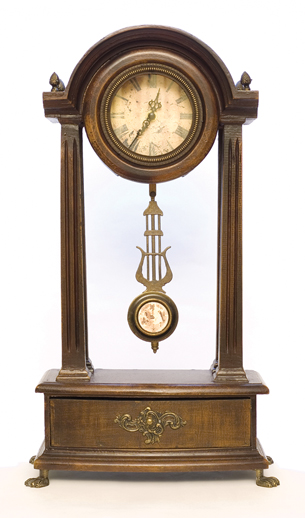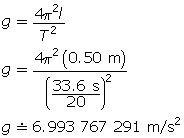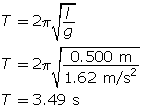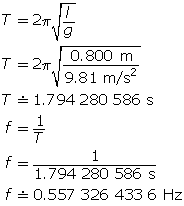Module 7—Oscillatory Motion
 Lesson 2 Lab: Equation for the Period of a Pendulum
Lesson 2 Lab: Equation for the Period of a Pendulum

© Garret Bautista/shutterstock
Problem
What is the equation for the period of a pendulum?
Open the Simple Harmonic Motion: Pendulum Motion simulation, and begin the Procedure.
You will use this simulation to complete the Period Measurements table. Save the table to your course folder. You will be updating the table in LAB 1, LAB 2, LAB 3, LAB 4, LAB 5, and LAB 6.
Procedure
Using the simulation, determine the period of the pendulum by doing the following:
- Reset the applet (
 ).
).
- Turn on the data display (
 ).
).
- Press “Play,” and carefully watch the pendulum move through ten complete cycles. (One cycle is complete every time the pendulum passes the starting position on its way up.)
LAB 1. Stop the simulation at the end of ten cycles. Use information from the data display to record the time for ten cycles in the Period Measurements table. Record your data under the column heading “With Default Settings.”
The time required to complete one cycle is the period of the pendulum. Now you will systematically investigate the effects of changing the angle of release (A), the mass (kg), length (m), and acceleration due to gravity (g).
Using the simulation, determine if the period of the pendulum is affected by the angle of release by doing the following:
- Reset the applet (
 ).
).
- Turn on the data display (
 ).
).
- Change the amplitude to the maximum value of 0.52 m (
 ).
).
- Press “Play,” and observe ten complete cycles. (One cycle is complete every time the pendulum passes the starting position on its way upward.)
LAB 2. From the data display, record the time for ten cycles in the Period Measurements table. Record the data under the column heading “With Modified Angle of Release.”
On the simulation, determine if the period of the pendulum is affected by the mass by doing the following:
- Reset the applet (
 ).
).
- Turn on the data display (
 ).
).
- Change the mass of the pendulum to the maximum value of 1.00 kg (
 ).
).
- Press “Play,” and observe ten complete cycles. (One cycle is complete every time the pendulum passes the starting position on its way upward.)
LAB 3. From the data display, record the time for ten cycles in the Period Measurements table. Record the data under the column heading “With Modified Mass.”
On the simulation, determine if the period of the pendulum is affected by the length of the pendulum by doing the following:
- Reset the applet (
 ).
).
- Turn on the data display (
 ).
).
- Change the length of the pendulum to the maximum value of 2.00 m (
 ).
).
- Press “Play,” and observe ten complete cycles.
LAB 4. From the data display, record the time for ten cycles in the Period Measurements table. Record the data under the column heading “With Modified Length.”
On the simulation, determine if the period of the pendulum is affected by the acceleration due to gravity by doing the following:
- Reset the applet (
 ).
).
- Turn on the data display (
 ).
).
- Change the acceleration due to gravity to the maximum value of 20.0 m/s2 (
 ).
).
- Press “Play,” and observe ten complete cycles.
LAB 5. From the data display, record the time for ten cycles in the Period Measurements table. Record the data under the column heading “With Modified Acceleration Due to Gravity.”
 Module 7: Lesson 2 Assignment
Module 7: Lesson 2 Assignment
Remember to submit the answer to LAB 6 to your teacher as part of your Module 7: Lesson 2 Assignment.
Observations
LAB 6. Find the average time for the completion of one cycle for each of the previous steps of the procedure. (You do this by dividing the time for ten cycles by ten.) Place your results in the appropriate cells in the Period Measurements table.
 Module 7: Lesson 2 Assignment
Module 7: Lesson 2 Assignment
Remember to submit the answers to LAB 7, LAB 8, LAB 9, LAB 10, and LAB 11 to your teacher as part of your Module 7: Lesson 2 Assignment.
Analysis
LAB 7. Has the period changed as a result of changing the angle of release? Explain.
LAB 8. Has the period changed as a result of changing the mass? Explain.
LAB 9. Has the period changed as a result of changing the length of the pendulum? Explain.
LAB 10. Has the period changed as a result of changing the acceleration due to gravity? Explain.
LAB 11. Summarize your findings from LAB 7 to 10 by listing the parameters that do affect the period of the pendulum and the ones that do not have an effect.
Conclusion
The period of a pendulum is the time required to complete one cycle or swing. The equation is as follows:
![]()
Quantity |
Symbol |
SI Unit |
period |
T |
s |
length |
l |
m |
acceleration due to gravity |
g |
m/s2 |
For small angles, the period of a pendulum depends only on its length and the acceleration due to gravity.
 Read
Read
Where did the equation above come from, and why is the period of a pendulum useful? Read “The Period of a Pendulum” on pages 377 to 379 of the textbook to find out.
The pendulum had immediate application in several areas of science. In addition to keeping good time, simple pendulums were used to measure the strength of Earth's gravitational field at various locations on Earth’s surface. Variations in the acceleration readings can be used to indicate the possible presence of heavy ores in the ground. In a sense, a precise pendulum is a metal detector!
Look over the next two examples to prepare for the Self-Check and Try This questions that follow.
Example Problem 2
If a pendulum is 80.0 cm long, what is its period and frequency of vibration?
Solution
Correct to 3 significant digits, the pendulum has a period of 1.79 s and a frequency of vibration of 0.557 Hz.
Example Problem 3
If on a previously unexplored planet, a probe found that a 50.0-cm pendulum completed 20 swings in 33.6 s, what would be the acceleration of gravity on that planet?
Solution
![]()

Correct to 3 significant digits, the acceleration of gravity on the planet is 6.99 m/s2.
 Self-Check
Self-Check
SC 1. Complete question 11 of “7.3 Check and Reflect” on page 380 of the textbook. Use 1.62 m/s2 for the value of g on the Moon.
 Self-Check Answers
Self-Check Answers
SC 1.
Given
l = 50.0 cm
g = 1.62 m/s2
Required
the period of the pendulum (T)
Analysis and Solution
The 50.0 cm length is 0.500 m.

Paraphrase
The period of the pendulum on the Moon is 3.49 s.
